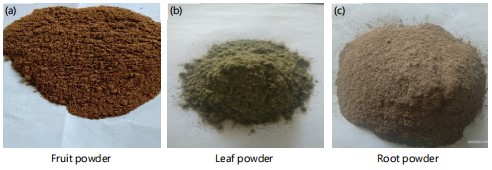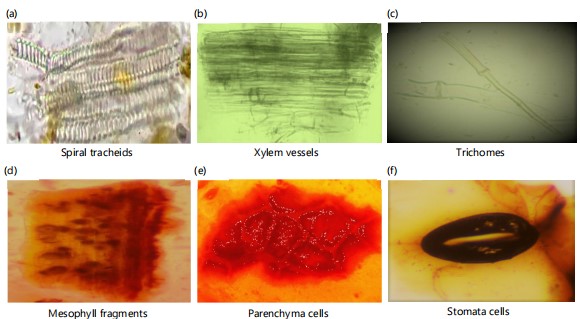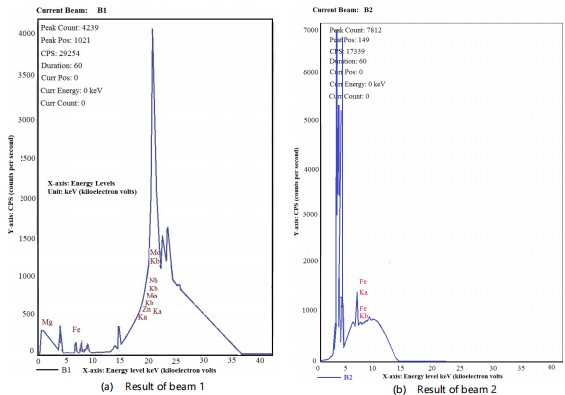Microscopical and Phytochemical Analysis of Fruit, Leaves and Roots of Fragaria nubicola (Lindl.Ex Hook.F.) Lacaita
| Received 12 Jan, 2025 |
Accepted 05 Mar, 2025 |
Published 30 Jun, 2025 |
Background and Objective: Developing countries continue to rely on plant-based remedies for disease treatment and prevention. The standardization of plant material can be checked by using pharmacognostic techniques. The current research work was carried out to investigate the macro, microscopical, and phytochemical features (Qualitatively) of the root, fruit, and leaf of F. nubicola. Materials and Methods: Standard methods were used to conduct the epidermal investigation on the leaf. Protocols were used to screen for qualitative phytochemicals. Different elements were found after a study of the elements was done using the X-ray Fluorescence (XRF) spectroscopy technique. The color, taste, texture, and aroma of leaves, roots, and fruit were revealed by their macroscopic properties. Green color for the leaf, pinkish-red for the fruit, and brownish for the root was observed. The statistical tools and techniques used for analyzing data include descriptive statistics, Chi-square test, frequency analysis, One-way ANOVA, and heatmaps. The standard significant levels were set at p<0.05. Results: Preliminary phytochemical tests of three chemical extracts indicated the presence of carbohydrates, alkaloids, terpenoids, phlobatannins, flavonoids, tannins, anthraquinones, and steroids in leaves. Similarly, substances were discovered in the plant fruit, including sugars, proteins, terpenoids, flavonoids, saponins, anthraquinones, and steroids. Numerous macro and microelements, including P, Zr, Fe, Si, Mn, Nb, Mo, Mg, and S, were found in fruits after an elemental analysis. They are considered to be essential to both the physiological functioning of plants and the effects of crude drugs. Conclusion: This research will provide a novel way for scientists to separate physiologically active components, which may help them find new compounds that can treat a variety of diseases.
| Copyright © 2025 Summan et al. This is an open-access article distributed under the Creative Commons Attribution License, which permits unrestricted use, distribution, and reproduction in any medium, provided the original work is properly cited. |
INTRODUCTION
Pharmacognosy refers to the scientific discipline that encompasses the identification, authentication (both macroscopic and microscopic), provenance (plant and animal sources), and quality control of natural products used in medicinal preparations1. Investigations into phytochemicals and phytochemistry have grown to be essential components of pharmacognosy as knowledge has grown and expanded. This field of science is multidisciplinary and translational. By standardizing and advancing crucial screening exams, targeted at pharmaceutical research at biologically relevant subatomic components, atomic science’s importance for therapeutic plants and contemporary medical chemistry highlights this wealth of fresh, suitable areas to create an unmistakably interdisciplinary science2.
Pharmacognosy is related to both traditional medicine, and pharmaceutics, and it supports pharmacists in the production of natural medicines. Data on extraction and purification processes significantly enhance the understanding of pharmacognosy. Modern technologies, such as plant tissue culture, are increasingly employed in the production of crude pharmaceuticals3. Pharmacognosy systematically investigates the properties of raw pharmaceutical materials, encompassing their chemical, structural, physical, and biological characteristics, alongside the methods used in drug production and collection within the pharmaceutical industry4.
Pakistan stands out as a unique region rich in natural resources and biodiversity, attributed to its diverse climatic zones. The country’s flora includes a vast array of medicinal plants, comprising herbs, shrubs, and trees. Approximately 6,000 species of medicinal plants have been documented in Pakistan5. These plants represent a valuable source for the extraction of bioactive constituents, offering considerable potential for application in pharmacognosy and pharmacology, as well as in the development of products for the pharmaceutical industry6.
Standardization is a method of producing medicinal material in which plant products, which are extracts in a specific solvent, are subjected to various chemical processes to isolate active ingredients, which may involve various phytochemical procedures as well as quality and percentage checks7. It is necessary to carry out the standardization of that specific plant to highlight its therapeutic values and quality control8.
In the field of taxonomy, alongside the standardization of herbal drugs, the identification and authentication of these drugs are equally crucial. Each species should be properly identified both in its fresh form and as a powdered specimen to ensure accurate classification and quality control9. To ensure the quality and purity of herbal medicine efforts should be carried for its appropriate identification. The standardization of plant material can be checked by using pharmacognostic techniques (i.e., a macroscopic, microscopic, and biological description of the plant material). Proper identification and authentication of medicinal plants can be brought about by different methods of evaluation proposed by the science of pharmacognosy10.
The removal of a key functional or active component from a plant renders the medication ineffective, directly compromising its quality. Research indicates that when contaminants are introduced into these drugs, people are more likely to lose trust in their efficacy and cease relying on them. Because of misunderstandings, and inconsistencies over the local names of the plants, adulteration may occur11. The effects of adulteration range from mild to moderate to severe, including cerebral edema, intracerebral hemorrhage, coma, metabolic acidosis, poisoning, and adverse effects. Fatigue, gastrointestinal distress, allergic reactions, nausea, muscle weakness, breathing issues, and discomfort are examples of minor effects. Moreover, effects include leucopenia, vomiting, and sensory disturbances. Confusion and adulteration are caused by the usage of different species with the same name and multiple local names for the same species. The presence of heavy metals and unknown medicines in many herbal products can result in adulteration. Adulteration primarily targets food products, and the supply chain of fresh goods can pose significant risks to consumers if not handled or consumed properly. Improperly processed or adulterated products can ultimately impact the health of consumers, potentially exacerbating existing medical conditions or introducing new health risks. Since there are more and more food producers, consumers need to be aware of adulteration and its effects on health. This is because a rising number of food producers are taking advantage of consumers by misleading and deceiving them12.
Anatomy deals with the arrangement of epidermal cells, vascular and ground tissue systems, and the nature and arrangement of specialized tissues within a particular organ of plants13. The microscopic analysis of powdered drugs involves measuring various cellular structures, with a focus on the length and width of tracheids, vessels, trichomes, and fibers. Additionally, it includes the identification of calcium oxalate crystals, starch grains, cork cells, sclerenchymatous cells, parenchymatous cells, and other distinguishing features to facilitate accurate authentication and quality assessment14.
High magnification microscopy has been utilized as a broad-spectrum method that, among other things, qualifies for the ability to thicken the picture by around 100 mm to examine plant anatomical components. Anatomy can be used to determine how a plant cell is organized within the plant. The study of plant cell and tissue structure focuses on the intricate organization within plant tissues. The internal architecture of plants has captivated scientific inquiry since the advent of microscopy. Research utilizing advanced techniques such as transmission and scanning electron microscopy has revealed detailed insights into various cell types, including sieve tubes and tracheal elements, each characterized by distinct, cell-specific properties. The substances that have the potential to combat various diseases, and are derived from plant resources are phytochemicals15. Secondary metabolites known as phytochemicals are important in the fight against diseases caused by bacteria, and insects16.
The identification, and isolation of active biochemical compounds and also secondary metabolites like tannins, alkaloids, phenols, sterols, glycosides, saponins, flavonoids, quinines, anthraquinones, and cardiac glycosides is primarily accomplished through qualitative, and quantitative phytochemical screening17.
The objectives of the study were to investigate the macroscopic elemental, and phytochemical analysis of fruit, leaves, and roots of Fragaria nubicola.
MATERIALS AND METHODS
Study area: Specimens of Fragaria nubicola were collected from Thandiani Forest, District Abbottabad, Pakistan, in July, 2023. Thandiani Forest, a moist temperate ecosystem, is renowned for its diverse flora and fauna. It is located approximately 35 km Northeast of Abbottabad City, and extends between 34°17-34°10 N Latitude and 73°23 -73°17 E Longitude, with an elevation range of 1,191-2,626 m above sea level. The forest is bordered by Muzaffarabad to the East, Siren Forest to the West, the Kunhar River and Garhi Habibullah to the North, and the Abbottabad Sub-Forest Division to the South18. Recent research in Thandiani has highlighted the area’s remarkable medicinal plant diversity, emphasizing its considerable ethnobotanical significance. Local communities continue to utilize these plant species in the treatment of various health conditions, showcasing the deep-rooted tradition of herbal medicine practiced in the region19.
Sample collection: The leaves, roots, and fruits of F. nubicola were collected from different sites of the Thandiani forest around 2400 and 2750 m amsl and plant extract was made.
Research protocol: Standard techniques were used to purify and evaluate the plant powder. The morphological features were accomplished utilizing the organoleptic evaluation approach, which includes odor, taste, and texture along with colour, size, shape, fractures, and margins of leaf, root, and fruit were analyzed by following the standard procedure20.
Free-hand section cutting was used to analyze the microscopic and anatomical characteristics of the roots, leaves, and fruits of the research plant. Following the creation of permanent slides, the length and width of each cell were measured during microscopy, and photography was then completed by observing under a microscope (Nikon Eclipse Ti-S). The Bolarinwa et al.21 technique was used to explore the anatomy of
the epidermis with just minor alternations. Powder drug analysis of F. nubicola was supported by succeeding the standard method with certain modifications to study the physical and microscopical characteristics22.
For examination of secondary metabolites phytochemical test was done on a powdered sample of leaves, roots, and fruits. Phytochemical analysis was done by following the qualitative microchemical tests procedure23. The qualitative phytochemical tests of methanolic, n-hexane, and aqueous extracts of Fragaria nubicola were carried out to find out carbohydrates, tannins, glycosides, saponins, terpenoids, phenols, alkaloids, flavonoids, quinines, anthraquinones, etc.
Identification of compounds: Different tests were used to identify compounds like Mayer’s reagent test for alkaloids, chloroform and ammonia solution test for glycoside4, acetic acid, ferric chloride, and sulphuric acid solution test for cardiac glycosides24, strong nitric acid test for proteins, Molisch’s test for detection of carbohydrates. Determination of phytosterols, H2SO4 in chloroform for triterpenoids and phytosterols, distilled water and ferric chloride test for phenols, 10% ammonia solution test for anthraquinones20, detection of anthraquinones, concentrated sulphuric acid test for quinine25, sodium hydroxide test for flavonoids4, ferric chloride test detection of tannins, Salkowski solution were used to test for terpenoids. The X-ray Fluorescence (XRF) spectroscopy (DRAWELL LAN Scientific, China) was used to determine the makeup of the elements.
Statistical analysis: The statistical tools and techniques used for analyzing data include descriptive statistics and Chi-square test for macroscopic and microscopical investigation, frequency analysis, and Chi-square test for phytochemical screening. For XRF spectroscopy (elemental analysis) descriptive statistics (mean, standard deviation) were used. One-way ANOVA and heatmaps were used for comparing elemental concentrations in roots, leaves, and fruits. The standard significant levels were set at p<0.05 (thresholds indicate a 5% probability).
RESULTS
Investigations into pharmacognosy were carried out by analyzing the macroscopic and microscopic characteristics of powder medications.
Macroscopic characters: The texture, flavor, scent, and color of F. nubicola fruit, root, and leaf powder are microscopically noticeable characteristics. In this research work, F. nubicola was observed organoleptically. The leaf powder has a greenish appearance, a fragrant scent, a bitter flavor, and a fine texture. The root powder is dark in color and has a fine texture. It tastes harsh and has a fragrant scent. The fruit powder color has a delicate texture and is pinkish. It smells strong and has a good flavor (Table 1 and Fig. 1(a-c)).
Microscopic study: The powder drug study, along with microscopy and transverse section of fruit, leaf, and root was analyzed (Table 2).
Analysis of powder drug: In the current study, several types of tracheids, sclerenchyma cells, epidermal non-glandular trichomes, parenchyma cells, epidermal cells, etc were measured to assess the powder medicine of F. nubicola. The finding showed that the powder medications contain epidermal cells, spiral tracheids, reticulated tracheids, and non-glandular trichomes among other things (Table 3-5 and Fig. 2-4).
The anatomical study of Fragaria nubicola revealed variations in cell morphology. Parenchyma cells were the largest (80×50 μm), while sclerenchyma cells were the smallest (22×16 μm). Cork cells exhibited significant length (78 μm) but minimal width (6 μm). Vessels (72×28 μm) and tracheids (59×20 μm for reticulate, 42×22 μm for pitted) showed structural diversity. Starch grains measured 40×20 μm, highlighting their storage function. These findings provide insights into the plant’s structural adaptations and potential physiological roles in Table 3.

|

|
| Table 1: | Macroscopic characteristics of F. nubicola | |||
| Parameters | Leaves | Fruit | Root |
| Taste | Sour | Sweaty | Sour |
| Odor | Strongly aromatic | Pleasant aroma | Strongly aromatic |
| Color | Green | Pinkish | Brownish |
| Texture | Herbaceous | Smooth | Rough |
| Table 2: | Microscopic characteristics of F. nubicola plant powder | |||
| Parameters | Roots | Leaves | Fruit |
| Microscopic characters of powder | |||
| Texture | Smooth, slightly woody | Fine, soft | Smooth |
| Color | Darkish brown | Green | Reddish |
| Odor | Aromatic | Aromatic | Pleasant |
| Taste | Slight sour | Bitter | Sweet |
| Table 3: | Microscopic features of powder drug analysis of root | |||
| Cell type | Length (μm) | Width (μm) |
| Epidermal cells | 26 | 21 |
| Parenchyma cells | 80 | 50 |
| Sclerenchyma cells | 22 | 16 |
| Cork cells | 78 | 6 |
| Starch grains | 40 | 20 |
| Vessels | 72 | 28 |
| Reticulate tracheids | 59 | 20 |
| Pitted tracheids | 42 | 22 |
The anatomical characteristics of Fragaria nubicola showed distinct variations in cell structure. Trichomes (82×8 μm) and pitted tracheids (84×18 μm) were among the longest structures, while spiral tracheids were the smallest (15×10 μm). Palisade parenchyma cells (68×16 μm) and mesophyll cells (55×33 μm) highlighted adaptations for photosynthesis. Thick-walled fibers (72×14 μm) and sclerenchyma cells (26×8 μm) provided structural support. Epidermal cells (44×25 μm) and stomata (19×9 μm) played key roles in gas exchange and protection. These findings contribute to understanding the plant’s functional morphology in Table 4.

|

|
| Table 4: | Microscopic features of powder drug analysis of leaf | |||
| Cell type | Length (μm) | Width (μm) |
| Epidermal cell | 44 | 25 |
| Sclerenchyma cell | 26 | 8 |
| Palisade parenchyma cell | 68 | 16 |
| Trichome | 82 | 8 |
| Thick-walled fibers | 72 | 14 |
| Pitted tracheids | 84 | 18 |
| Spiral tracheid | 15 | 10 |
| Mesophyll cell | 55 | 33 |
| Stomata | 19 | 9 |
| Table 5: | Microscopic features of powder drug analysis of fruit | |||
| Types of cells | Length (μm) | Width (μm) |
| Parenchyma cells | 145.5 | 16.3 |
| Reticulate trachieds | 36 | 14.2 |
| Spiral trachieds | 150.2 | 22 |
| Epidermal cells | 80.5 | 21 |
| Sclerenchyma cells | 74.8 | 40.2 |
| Epidermal non-glandular trichome | 210 | 12.6 |
| Table 6: | Epidermal anatomy of Fragaria nubicola leaf (qualitatively) | |||
| Features | Observation |
| Shape of epidermal cell | Rectangular shape |
| Epidermal layer | Single layered |
| Margins of epidermal cell | Rough |
| Presence and absence of trichome | Trichome present |
| Type of trichome | Uniseriate trichome |
| Absence and presence of stomata | Present on the abaxial side |
| Guard cell shape | Bean shape cell |
| Type of stomata | Anomocytic |
| Table 7: | Quantitative characters of leaf (Fragaria nubicola) | |||
| Quantitative character | Observation (μm) |
| Number of epidermal cells/area | 270-290 |
| Epidermal cell Width | 16 |
| Length of epidermal cell | 40 |
| Stomatal length | 13 |
| Stomatal width | 11 |
| Number of stomata/areas | 16 |
| Length of guard cells | 25 |
| Width of guard cells | 10 |
| Number of trichome | 1 |
| Width of trichome | 0.75 |
| Length of trichome | 7.25 |
The anatomical study of Fragaria nubicola revealed significant variations in cell structure. Epidermal non-glandular trichomes were the longest (210×12.6 μm), followed by spiral tracheids (150.2×22 μm) and parenchyma cells (145.5×16.3 μm), indicating structural adaptations. Sclerenchyma cells (74.8×40.2 μm) exhibited the greatest width, contributing to mechanical support. Reticulate tracheids (36×14.2 μm) and epidermal cells (80.5×21 μm) played roles in transport and protection. These findings enhance the understanding of the plant’s physiological and structural properties in Table 5.
Epidermal anatomy: Abaxial and Adaxial surfaces of the epidermis were identified. According to quantitative investigation, the stomata on the Abaxial and Adaxial surfaces were of the anomocytic type. There were stomata on the Adaxial surface. The stomatal guard cells resemble beans shape (Table 6).
Quantitative research revealed that values for the stomata and epidermis were recorded. There were 135 stomatal pores and between 270 and 290 epidermal pores. Under a 10χ microscope, the trichomes, guard cells, and epidermal cells were measured in millimeters (Table 7).
Measurement of stomatal index: Only the lower epidermis had stomata, the top epidermis was absent of them. The stomatal index (31.7) was calculated by counting the number of stomata (135), epidermis cells (290), and other factors, and shown in Table 7.
Elemental analysis: In the present research work fruit of F. nubicola was analyzed to determine the various mineral elements. The maximum average value was recorded for Fe (47.06), followed by Mg (24.76) and Zn (21.51) while the minimum value was recorded for S (0.059) and Si (0.099) (Table 8 and Fig. 5).
Qualitative phytochemical analysis
Phytochemical analysis of Fragaria nubicola roots: All three extracts n-hexane, methanolic, and distilled water report the presence of phytochemicals such as glycosides, flavonoids, and phlobatannins. However, distilled water does not record alkaloids and methanolic solvent does not include coumarins flavonoids. Fixed oil was absent (Table 9).

|
| Table 8: | Elemental analysis of F. nubicola fruit | |||
| Minerals | R1 (%) | R2 (%) | R3 (%) | Mean |
| Fe | 51.528 | 42.175 | 47.488 | 47.06 |
| Mg | 26.736 | 24.359 | 23.197 | 24.76 |
| Zn | 24.343 | 26.01 | 14.182 | 21.51 |
| Mo | 13.38 | 18.505 | 5.66 | 12.51 |
| Nb | 14.328 | 14.305 | 8.637 | 12.42 |
| Mn | 13.097 | 11.231 | 0.0197 | 8.115 |
| P | 0.793 | 0.095 | 0.102 | 0.33 |
| Si | 0.297 | 0.0000 | 0.0000 | 0.099 |
| S | 0.037 | 0.062 | 0.079 | 0.059 |
| Table 9: | Phytochemical analysis of Fragaria nubicola roots | |||
| Secondary metabolites | n-hexane | Methanol | D. water |
| Saponins | - | + | + |
| Carbohydrates | - | + | + |
| Coumarins | + | - | + |
| Phlobatannins | - | - | - |
| Anthraquinones | - | + | + |
| Glycoside | - | - | - |
| Quinine | + | + | + |
| Terpenoids | + | + | + |
| Flavonoids | + | + | - |
| Tannins | - | + | + |
| Phenols | - | + | + |
| Alkaloids | + | + | - |
Phytochemical analysis of Fragaria nubicola leaves: All three extracts n-hexane, methanolic, and distilled water contain phytochemicals such as phlobatannins and glycosides. Methanolic and n-hexane solvents are absent of coumarins, anthraquinones, quinine, and terpenoids, whereas distilled solvents are free of saponins. Fixed oil was present (Table 10).
| Table 10: | Phytochemical analysis of Fragaria nubicola leaves | |||
| Secondary metabolites | n-hexane | Methanol | D. water |
| Saponins | - | + | - |
| Carbohydrates | + | - | + |
| Coumarins | - | - | + |
| Phlobatannins | - | - | - |
| Anthraquinones | - | - | + |
| Glycosides | - | - | - |
| Quinines | - | - | + |
| Terpenoids | - | - | + |
| Flavonoids | + | - | + |
| Tannins | + | + | + |
| Phenols | + | + | + |
| Alkaloids | + | + | + |
| Table 11: | Phytochemical analysis of Fragaria nubicola fruit | |||
| Secondary metabolites | n-hexane | Methanol | D. water |
| Saponins | - | + | - |
| Carbohydrates | + | + | - |
| Coumarins | + | + | + |
| Phlobatannins | - | + | - |
| Anthraquinones | - | - | - |
| Glycoside | - | - | - |
| Quinine | + | + | + |
| Terpenoids | - | + | + |
| Flavonoids | - | + | + |
| Tannins | - | + | + |
| Phenols | - | + | + |
| Alkaloids | + | - | - |
Phytochemical analysis of Fragaria nubicola fruit: Glycosides and anthraquinones are two phytochemicals that are not found in any of the three extracts of n-hexane, methanol, and distilled water. Saponins and also phlobatannins are absent in both the distilled water and n-hexane extract. While the quinine and coumarins were present in all three solvents. Fixed oil was present (Table 11).
DISCUSSION
The majority of conventional medications are prepared using natural components that are mostly derived from plants. The Rosaceae family includes Fragaria nubicola, which has several therapeutic applications26,27. This study’s objective is to assess the pharmacognostic properties of F. nubicola fruits, roots, and leaves. The research on F. nubicola aimed to standardize its medicinal properties and explore its characteristics, as Indigenous communities have long utilized various parts of the plant to treat a wide range of ailments28. Different plant parts have been traditionally employed to address health issues such as skin conditions, cardiovascular diseases, wounds, and gastrointestinal disorders. The phytochemical, elemental analysis, powder drug, phytotoxic, cytotoxic, and antibacterial, and antioxidant activities of this plant were all examined. The study plant F. nubicola has some significant biological tests against numerous illnesses, according to literature review29.
Pharmacognostic investigations were conducted by examining the macroscopic and microscopic characteristics of powdered medications derived from the fruit, root, and leaf of F. nubicola. A similar study was undertaken by Bhutia et al.29 who worked on physico-chemical properties and nutritional composition of fruits of the wild Himalayan strawberry (Fragaria nubicola) in different ripening stages. Organoleptic evolutions and microscopic examinations of the leaf root and fruit powder drugs revealed the presence of many cells, including epidermal, cork, parenchymatous, sclerenchymatous, phloem fiber, sclerieds, and medullary ray cells. The maximum length in powder root was recorded for Parenchyma cells (80 μm) followed by Cork cells (78 μm) while the minimum length was recorded for Sclerenchyma cells (22 μm).
In powder, leaf analysis indicated that the maximum length was 84 μm for the Pitted tracheid followed by the Trichome while the minimum length was 15 μm for the Spiral tracheid. In fruit maximum length was 210 μm for the Epidermal non-glandular Trichome followed by 150.2 μm for the Spiral Tracheids. Current results were in line with the findings of Shrestha et al.26 who worked on F. nubicola.
In the present research work fruit of F. nubicola was analyzed to determine the various mineral elements. The maximum average value was recorded for Fe (47.06), followed by Mg and Zn while the minimum value was recorded for S and Si. Our results are in line with the findings of Faizul Haq et al.28 and Bhutia et al.29.
According to the phytochemical analysis of the roots distilled water, n-hexane, and methanolic extracts quinine, terpenoids, carbohydrates, anthraquinones, alkaloids, and flavonoids are highly abundant, whereas glycoside and phlobatannins are lacking. While plant leaves missing tannins, phlobatannins, and glycosides but are abundant in flavonoids, phenols, and alkaloids. The fruits of the plant reveal that it is full of coumarins, quinine, carbohydrates, tannins, and phenols. Fruit lacks anthraquinones, glycosides, and similar compounds plant secondary metabolites are bioactive substances that improve health. Terpenoids, flavonoids, and polyphenols are often used to categorize secondary metabolites from plants.
In a similar vein, Shrestha et al.26 report the discovery of secondary metabolites from the genus Fragaria. The healthcare system is significantly impacted by phytochemicals, which may also provide therapeutic benefits for health. Specific pharmaceutical effects on the human healthcare system may offer therapeutic health advantages in addition to therapy. Specific pharmacological effects on human health are carried out with the aid of these phytochemicals, including those that are carminative, heart diseases, and cancer, also protect from carcinogenesis, antiaging, diuretic, analgesic, neuroprotective, chemopreventive, anti-inflammatory, anti-allergic, antibacterial, antispasmodic, antifungal, and antioxidants.
CONCLUSION
The macroscopic and microscopic characteristics of Fragaria nubicola set it apart from other members of the genus. F. nubicola various secondary metabolites, including tannins, alkaloids, saponins, carbohydrates, glycosides, terpenoids, phenols, phlobatannins, coumarins, and quinines are found in various parts of plant fruits, leaves, and roots according to phytochemical studies. Numerous elements including Fe, Mn, Zn, and Nb were present in the fruit of the plant. According to the findings of the current study, plants must include some active cytotoxic components because they have the potential to be cytotoxic. Plants have a tremendous capacity for antioxidants, which has many positive health effects. Plants exhibit phytotoxic, cytotoxic, and antimicrobial potentials, making them promising for developing weed control, new drugs, and antibiotics. Future studies should focus on isolating bioactive compounds, conducting in-vivo and in-vitro experiments, and raising awareness about sustainable utilization.
SIGNIFICANCE STATEMENT
This study discovered the unique macroscopic and microscopic characteristics of Fragaria nubicola, along with its diverse secondary metabolites and elemental composition, which can be beneficial for pharmacological and agricultural applications. The findings highlight the plant’s cytotoxic, phytotoxic, and antimicrobial potentials, making it a promising candidate for developing new drugs, antibiotics, and natural herbicides. This study will help researchers uncover the critical areas of bioactive compound isolation and their therapeutic applications that many researchers were not able to explore. Thus, a new theory on the sustainable utilization and medicinal potential of F. nubicola may be arrived at.
REFERENCES
- Balunas, M.J. and A.D. Kinghorn, 2005. Drug discovery from medicinal plants. Life Sci., 78: 431-441.
- Shaheen, L., Faizul Haq and S. Faisal, 2025. Environmental influence on phytochemicals, phenolic compounds and antioxidant activity in flower, leaf and root extracts of Fumaria indica L. Asian J. Biol. Sci., 18: 458-466.
- Begum, S., M. Muhammad, Faizul Haq, A. Gul and G.M. Shah, 2024. Phytochemical composition and microscopic characteristics of the fruit bark of Punica granatum L. Asian J. Biol. Sci., 17: 192-201.
- Kokate, C.K., A.P. Purohit and S.B. Gokhale, 2007. Pharmacognosy. 40th Edn., Nirali Prakashan, Pune, India, ISBN: 9788185790091, Pages: 635.
- Faizul Haq and Rahat Ullah, 2011. Comparative determination of trace elements from Allium sativum, Rheum australe and Terminalia chebula by atomic absorption spectroscopy. Int. J. Biosci., 5: 77-82.
- Ozturk, N. and Y. Ozturk, 2008. Opportunities and threats for biological screening of medicinal plants: Importance for the pharmaceutical industries in developing countries. World Rev. Sci. Technol. Sustainable Dev., 5: 124-139.
- Rehman, N., Faizul Haq and S. Faisal, 2023. Phytochemical analysis and antioxidant potential of Calotropis procera and Calotropis gigantea. Asian J. Biol. Sci., 16: 254-263.
- Venkatesh, S., B.M. Reddy, B. Suresh, M.M. Swamy and R. Mullangi, 2004. Pharmacognostical identification of Rumex nepalensis Spreng (Polygonanceae)-an adulterant for Indian Rhubarb. Nat. Prod. Sci., 10: 43-47.
- Springfield, E.P., P.K.F. Eagles and G. Scott, 2005. Quality assessment of South African herbal medicines by means of HPLC fingerprinting. J. Ethnopharmacol., 101: 75-83.
- Bahukhandi, A., A. Barola and K.C. Sekar, 2020. Antioxidant activity and polyphenolics of Fragaria nubicola: A wild edible fruit species of Himalaya. Proc. Natl. Acad. Sci. India Sect. B: Biol. Sci., 90: 761-767.
- Mitra, S.K. and R. Kannan, 2007. A Note on unintentional adulterations in ayurvedic herbs. Ethnobotanical Leafl., 11: 11-15.
- Tura, A.G. and D.B. Seboka, 2019. Review on honey adulteration and detection of adulterants in honey. Int. J. Gastroenterol., 4: 1-6.
- Dengler, N.G., 2002. An integral part of botany. Am. J. Bot., 89: 369-374.
- Faizul Haq, Shams ur Rehman, H. Ahmad, Z. Iqbal and Rahat Ullah, 2012. Elemental analysis of Paeonia emodi and Punica granatum by atomic absorption spectroscopy. Am. J. Biochem., 2: 47-50.
- Chung, K.T., C.I. Wei and M.G. Johnson, 1998. Are tannins a double-edged sword in biology and health? Trends Food Sci. Technol., 9: 168-175.
- Cowan, M.M., 1999. Plant products as antimicrobial agents. Clin. Microbiol. Rev., 12: 564-582.
- Johansen, D.A., 1940. Plant Microtechnique. McGraw-Hill Book Company, Incorporated, New York, ISBN: 9780070325401, Pages: 523.
- Khan, W., S.M. Khan, H. Ahmad, A.A. Alqarawi, G.M. Shah, M. Hussain and E.F. Abd_Allah, 2018. Life forms, leaf size spectra, regeneration capacity and diversity of plant species grown in the Thandiani Forests, District Abbottabad, Khyber Pakhtunkhwa, Pakistan. Saudi J. Biol. Sci., 25: 94-100.
- Summan, S. Faisal and Faizul Haq, 2025. Exploring the therapeutic potential of Fragaria nubicola: Antimicrobial, phytotoxic, cytotoxic, and antioxidant properties. Asian J. Biol. Sci., 18: 615-624.
- Evans, W.C., 2009. Trease and Evans' Pharmacognosy. 16th Edn., Elsevier Health Sciences, Maryland, United States, ISBN: 9780702041891, Pages: 616.
- Bolarinwa, I.F., P.T. Lim and K. Muhammad, 2019. Quality of gluten-free cookies from germinated brown rice flour. Food Res., 3: 199-207.
- Wallis, T.E., 1967. Textbook of Pharmacognosy. 5th Edn., Churchill, London, United Kingdom, ISBN: 9780700012916, Pages: 652.
- Atta-Ur-Rahman, S.A. Abbas, F. Nighat, G. Ahmed and M.I. Choudhary et al., 1991. Chemical constituents of Alstonia macrophylla. J. Nat. Prod., 54: 750-754.
- Sofowara, A., 1993. Recent trends in research into African Medicinal plants. J. Ethanopharmacol., 38: 197-208.
- Hussain, I., Moneeb Ur Rehman Khattak, Riaz Ullah, Z. Muhammad and N. Khan et al., 2011. Phytochemicals screening and antimicrobial activities of selected medicinal plants of Khyberpakhtunkhwa Pakistan. Afr. J. Pharm. Pharmacol., 5: 746-750.
- Shresta, S., R.M. Kunwar, H.A. Jan, A.M. Abbasi, R.W. Bussmann and N.Y. Paniagua-Zambrana, 2021. Fragaria nubicola (Hook. f.) Lindl. ex Lacaita Rosaceae. In: Ethnobotany of the Himalayas, Kunwar, R.M., H. Sher and R.W. Bussmann (Eds.), Springer, Cham, Switzerland, ISBN: 978-3-030-57408-6, pp: 941-950.
- Hussain, S.A., S. Ahmad, Z.A. Butt, Khushnood Ur Rehman, Saqib Ullah and S.S. Khan, 2021. Flavonoids, alkaloids, and saponins as antimicrobial agents from Fragaria vesca L. Pure Appl. Biol., 10: 761-769.
- Faizul Haq, H. Ahmad and M. Alam, 2011. Traditional uses of medicinal plants of Nandiar Khuwarr catchment (District Battagram), Pakistan. J. Med. Plant Res., 5: 39-48.
- Bhutia, P.O., P. Kewlani, A. Pandey, S. Rawat and I.D. Bhatt, 2021. Physico-chemical properties and nutritional composition of fruits of the wild Himalayan strawberry (Fragaria nubicola Lindle.) in different ripening stages. J. Berry Res., 11: 481-496.
How to Cite this paper?
APA-7 Style
Summan, Faisal,
S., Shah,
G.M., Haq,
F., Abbassi,
A.M. (2025). Microscopical and Phytochemical Analysis of Fruit, Leaves and Roots of Fragaria nubicola (Lindl.Ex Hook.F.) Lacaita. Trends in Agricultural Sciences, 4(2), 82-93. https://doi.org/10.17311/tas.2025.82.93
ACS Style
Summan; Faisal,
S.; Shah,
G.M.; Haq,
F.; Abbassi,
A.M. Microscopical and Phytochemical Analysis of Fruit, Leaves and Roots of Fragaria nubicola (Lindl.Ex Hook.F.) Lacaita. Trends Agric. Sci 2025, 4, 82-93. https://doi.org/10.17311/tas.2025.82.93
AMA Style
Summan, Faisal
S, Shah
GM, Haq
F, Abbassi
AM. Microscopical and Phytochemical Analysis of Fruit, Leaves and Roots of Fragaria nubicola (Lindl.Ex Hook.F.) Lacaita. Trends in Agricultural Sciences. 2025; 4(2): 82-93. https://doi.org/10.17311/tas.2025.82.93
Chicago/Turabian Style
Summan, Shah Faisal, Ghulam Mujtaba Shah, Faizul Haq, and Arshad Mehmood Abbassi.
2025. "Microscopical and Phytochemical Analysis of Fruit, Leaves and Roots of Fragaria nubicola (Lindl.Ex Hook.F.) Lacaita" Trends in Agricultural Sciences 4, no. 2: 82-93. https://doi.org/10.17311/tas.2025.82.93

This work is licensed under a Creative Commons Attribution 4.0 International License.




